

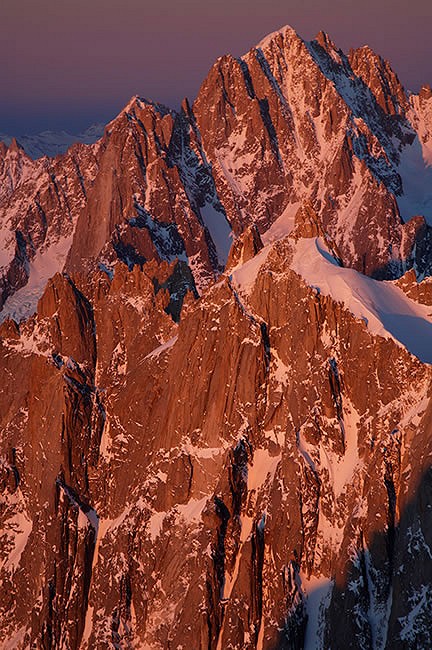
It's becoming a very rare thing to find solitude in the mountains of Chamonix, as the ease of access combined with some of the highest mountains in Europe means that even on the hardest routes you can find yourself waiting at belays. When I compare it to the Bernese Oberland where you can not see a soul for days it makes me wonder why I am here in the first place. But then I am here for the same reason everyone is - for some of the best, easy access, climbing and skiing in Europe.
If you do want to veer off the beaten track and immerse yourself in the mountains without too much risk then I can highly recommend descending the Vallee Blanche under a full moon. Glaciers under a full moon provide ample light to climb and ski without any need for a head torch. Last month was no exception and with a high full moon arching over the sky, we decided to get the last lift up the Aiguille du Midi.
The Vallee Blanche is one of the most scenic ski descents I have ever done in my life. First skied in February 1903 it has become one of the most famous ski runs in the world. Incorporating over 17km of breath-taking glacial scenery and huge open valleys, passing under some of the most famous peaks and faces in the Alps, all in the eerie lunar light, it is wild. Traditionally you can ski straight from the Aiguille du Midi (3842m) to Chamonix town itself covering a total of 25kms and nearly 2800m of vertical descent. However in recent years the path has not been ski-able to the town due to poor snow fall, so you can only ski to the Montenvers train at the end of the Vallee Blanche. From there it is possible to take the train back to Chamonix. It's worth noting that the train does not run past 5pm, so any descent at night will end up in either sleeping at the train station or long walk down to Chamonix in ski boots. >
Armed with sandwiches, tea, and the obligatory pack of cards, we arrived at the Aiguille du Midi and awaited the sunset. I've spent many nights up at the Midi and it still remains one of the best places to watch the sunset in the French Alps. To your right you have the impressively crevassed and avalanched scarred South faces of the Mont Blanc, Maudit and Tacul, on your left you have the sheer rock walls of the Chamonix Aiguilles, with the Verte and Drus rising up in the background. Tying them all together is the imposing and historical North Face of the Grandes Jorasses, a truly impressive site when bathed in the last dying rays of the sun. That's when it starts to get cold, very cold. No matter though as the 'lifties' at the Aiguille du Midi are kind enough to leave a heated toilet area open for late Alpinists so there we sat for the next 4 hours waiting for the moon to rise high enough to set off.
At around 9pm it was time to finish the last of supper and take a few photos of the starkly changed panorama. Only a few hours earlier we witnessed the last of the day's colour, now we were plunged into a monochrome landscape of bone white and deep black.
Throwing Simon out on to the Cosmiques for a few shots of Mont Blanc,we headed over to the Midi tunnel and cramponed-up. In the winter they set up a rope banister system down the snow arête, avoiding anyone hurtling down the North face of the Midi, so anyone who has had a bad vertigo experience in the summer will not have to go through the same experience again!
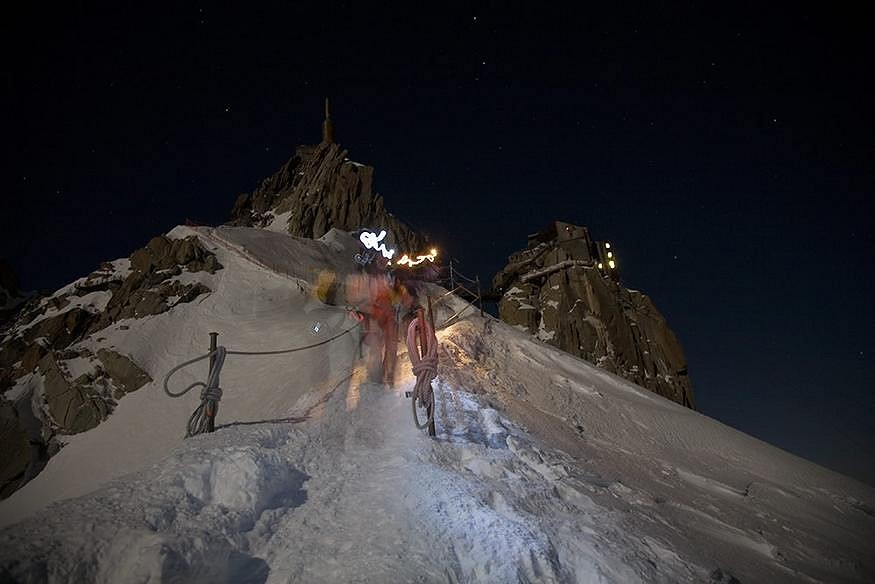
With the lights of Chamonix far below and the infamous peaks of the Verte, Courtes and Droites exposing their impressive shrouded West Faces cascading down to the contrastingly illuminated Talefre basin below, we knew we were in for a special night. 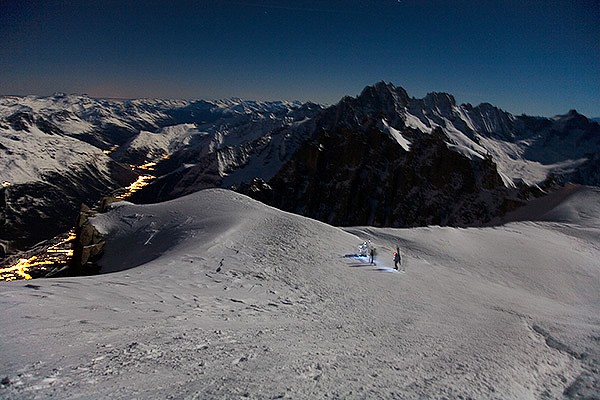
As you ski down under the South face of the Midi, you pass in front of Mont Blanc du Tacul which never ceases to impress, burdened as it is with tumbling seracs, set to hurl themselves off the mountain and crash down upon the glacier below, leaving behind ice blocks the size of cars that sparkle in the moon light. In this odd light you feel even more humbled by its towering presence over you and even more so by the complete and total silence that is such a rarity in this overcrowded part of the Alps.
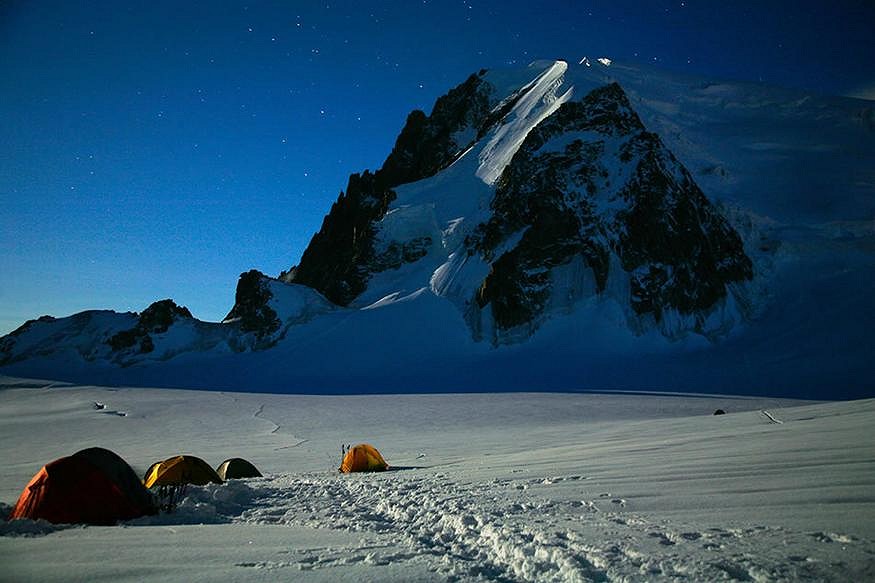
Continuing past the Rognon, carving turns beneath the Tacul East face there is time to take in some of the more famous routes such as Supercouloir and the Modica-Noury - rivers of mercury snaking their way down the darkened rock that towers overhead. The ever menacing serac band and cornice that hang dangerously over the Gervasutti couloir somehow look less threatening at night, as if they were part of a different dream world entirely. Having spent four hours in the comfort of the heated Midi station and now speeding by on skis, it's easy to drift in to another world where the seracs wont affect you at all, and it's not until you ski between large green blocks of ice that have recently torn themselves off the huge serac band by the Petit Capucin that you realise it's just that bit more dangerous. 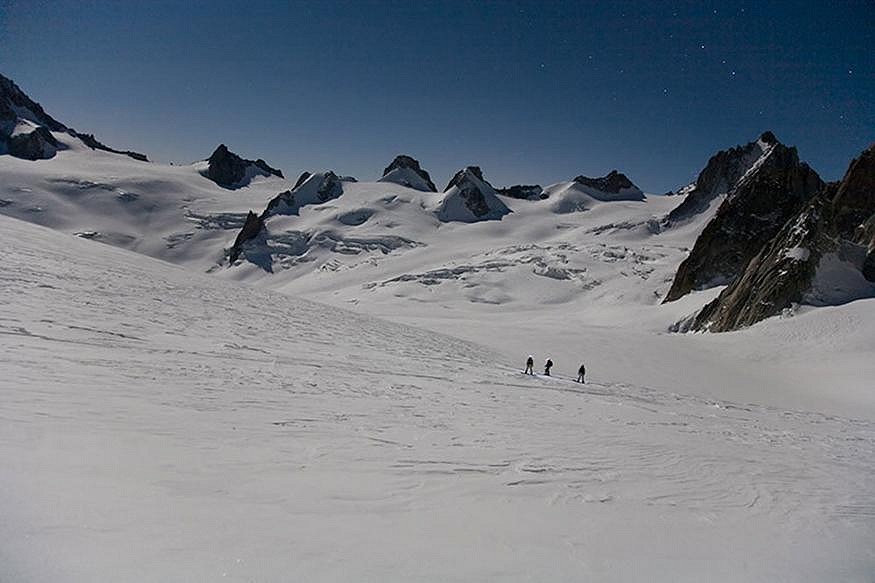

Smiles all round and we find ourselves approaching the crevassed area by the Requin Hut. This is perhaps the most objectively dangerous part of the Vallee Blanche as not only do you have a very tumbled glacier on your right but up on your left you have a whole series of smaller seracs that fall quite regularly - essentially you find yourself in a bit of a tight squeeze with 'death' on your left and 'death' on your right. Whilst they aren't huge they can certainly cause some damage so it's advisable to ski past this section as fast as possible. Unfortunately I'm hooked on photography like it's a filthy crack habit so I cant stop myself from standing under a few interestingly poised seracs to take some photos of the glacier and my mates below the convoluted Geant Glacier with the Dent Du Geant looming up over head. 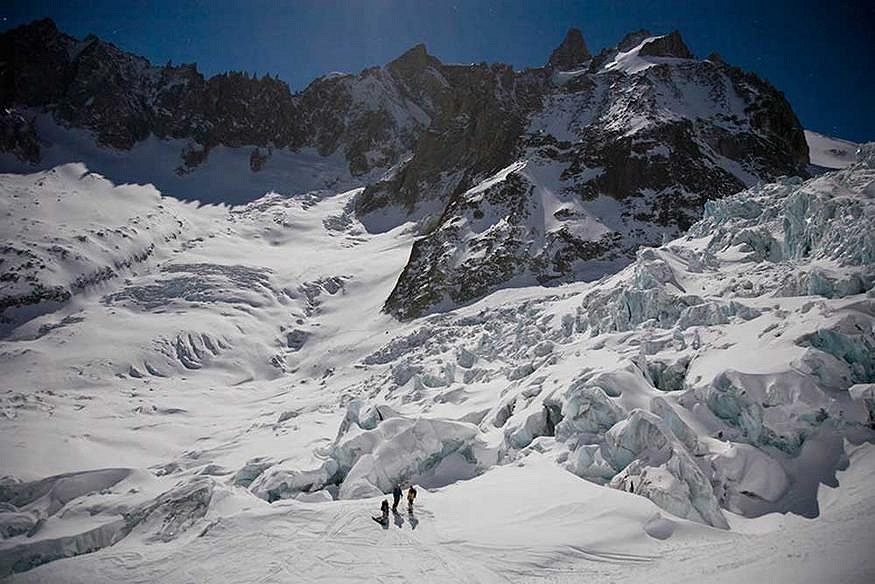
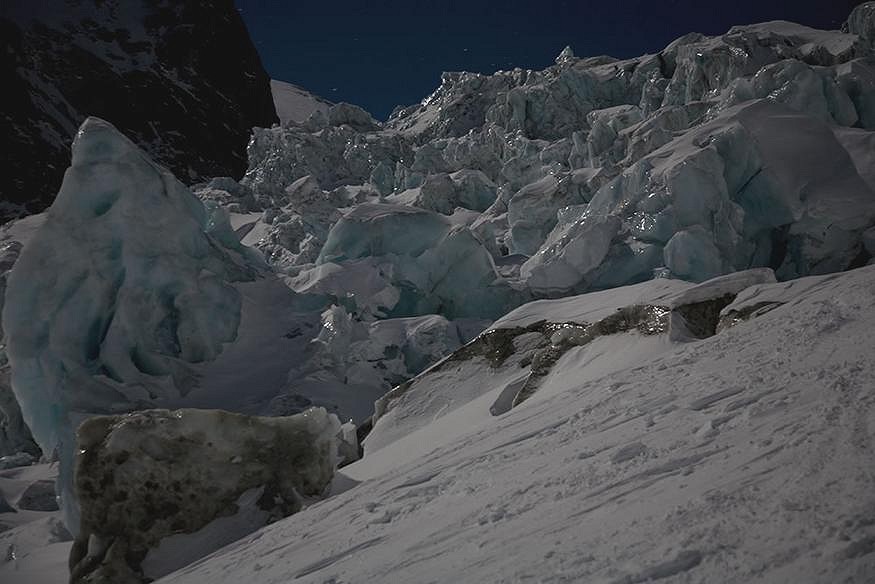
A couple of creaks and groans from the glacier underfoot and it's a good sign to get the hell out of there which is just what we do and before you know it you are speeding down across the enormously flat and wide expanse of the lower part of the Mer De Glace. A snowboarders nightmare yes, but even they cant stop themselves from looking up at the appropriately named Chamonix 'Needles' and then, further along, back up at the North face of the Grandes Jorasses that looks even more daunting than usual as this season's black ice on the Shroud and other routes seem to absorb rather than reflect the light living up to the route's name.
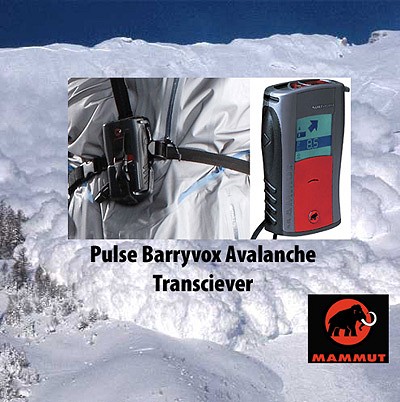
Two battered and bruised snowboarders later and you arrive on the Planards slope which is the first time in 24kms that you can just point your skis down and really pick up speed and as the last rush of adrenaline surges through your body and you ski down past 'apres-ski' revellers returning home on the iced up roads, you realise that at least you will remember this night.
The Photography
For those interested in taking night-time shots it's a bit more of an effort but definitely worth it. Unless you have the kind of on demand rigamortis of a Queen's Guard then you are going to need a sturdy tripod. Bearing in mind that your shutter will be open for upwards of 20 seconds its worth getting a heavy one as even the slightest gust of wind can ruin your image, and lets face it its quite rare for the mountains to be wind free.
Another tip is try and shoot with a low ISO on digital cameras. I have found that I get really bad noise levels in the darker areas when using a digital SLR. So I always try and shoot at the lowest ISO I can and just compensate by leaving the shutter open for longer (something like ISO125). Also if in doubt always overexpose your shot. If you have an underexposed night shot then trying to lighten it in a photo editing software will make the noise in the darker areas even more accentuated. If you overexpose its much easier just to darken the image slightly and you wont have any noise issues.
If you want to include people in your photo then they will have to try and stay as still as possible for the duration that the shutter is up. Unfortunately your figures tend to come out rather dark so I get one of them to simply hold out a normal standard compact and take shots of themselves (i.e. the flash on the camera helps bring them out)
Don't expect perfect photos the first time you try it out too. It's a different type of photography as you have to realise that there are going to be very lit up areas and very darkened areas, so whilst it may look good to the naked eye, getting in too much 'shade' will actually not look so good when on screen- and even worse in print. My final tip is be patient! Not only does it take longer for the shot to capture on film/sensor but you also will have to manually focus in as well as set up the tripod on each occasion. As opposed to normal-lit scenes which can take a few seconds to take a shot, I often take a few minutes at night. Since it takes a while to capture each shot it's also worth getting the right shot first time, take time to compose it properly.
Happy shooting
Jon and his photography
Jon first started out on an old FM5 manual SLR and quickly realised that he had a passion for photographing people in some of the most beautiful landscapes- even if he hadn't quite worked out how to fully work a manual camera! After dedicating nearly all of his university holidays away in the French and Swiss Alps he moved out to Chamonix after graduating to pursue a career in photography and has never looked back. He has been published in the major climbing and skiing magazines in both the US and the UK, as well as done commercial work for larger companies such as Osprey and Easyjet. He now works full time as a freelance photographer as well as running and setting up the Alpine Exposures company and site. 
Jon Griffith - age: 24 - Chamonix
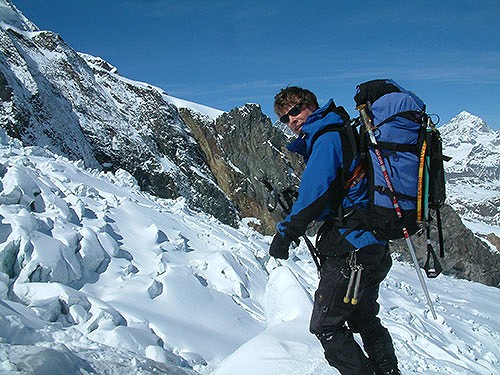
From then on I took advantage of the huge university holidays and tried to spend a maximum amount of time out in the Alps. I spent my first few years out in Zermatt (thanks to my climbing partner at the time Brian Birtle who put me up countless times) getting more into the mixed and alpine element rather than just rock climbing Chamonix style stuff. I finished my 'time' out in Zermatt on a high point with the Lyskamm North Face and decided I was ready to move on and try Chamonix style rock routes. I finished university last summer and moved out to Chamonix where I am currently working in photography and film work.
It's hard to pick one specific type of climbing that I prefer over the
others but I think my heart still lies with big mixed alpine routes
that potentially involve a couple of nights bivying. I am still
getting used to the whole Chamonix 'get back in time for the last
lift' style- I still include bivying as a part of any decent
mountaineering experience. I am also still getting used to crack
climbing- it hurts.... a lot.

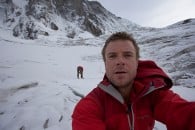








Comments